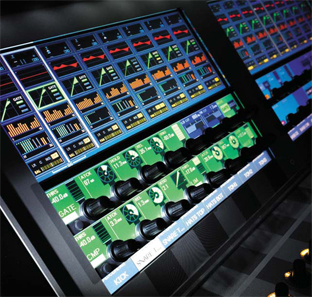The increasing complexity of the average AV project can be as much a burden as it is a blessing. None of us should complain about the fact that our customers are asking for deeper and deeper integration of
Customers don’t just want integration—they want unified control of all their technologies, they want it fast, and they want it easy. an increasingly diverse range of technologies. After all, this demand is one of the things that has enabled so many systems firms to keep piloting a course along the growth curve for so long. The problem is that customers don’t just want integration—they want unified control of all their technologies, they want it fast, and they want it easy.
This should not surprise us. One of the drivers behind integration is the desire on the part of customers to have a single place from which they can control their electronic systems, and a series of automated tasks that can be triggered by a simple button press or two. It is this desire that has fuelled the phenomenal growth of control system manufacturers such as AMX and Crestron, and of their dealer networks, in both commercial and residential applications.
Even so, at one time, selling the concept of a centralized user interface wasn’t always plain sailing. It wasn’t that customers didn’t want such control; it was simply outside their frame of reference. According to Jeff Kindig, vice president, strategic marketing at AMX, this is a scenario that consumer technology has changed for the better.
“The good news is that the increasing popularity of devices such as iPhones and iPod Touches, which offer very intuitive user interfaces, means our end customer is becoming much more educated in what the possibilities are,

When it came to re-engineering its technology for the Vi Series of consoles, Soundcraft had to make a number of key revisions to reflect the fact that, unlike many control interfaces, a live sound console is often used in a volatile situation. ” Kindig reasoned. “This in turn is helping to facilitate the conversation between the customer and the dealer. In the past, the customer didn’t know what a user interface might look like. Now they’re much more comfortable and, fortunately, in the case of the Apple products they’re being educated in a good way about something that really works. The question ‘why would I want that here?’ doesn’t come up any more.”
The flipside to this coin is that because customers have become better educated, they are much less likely to be impressed with a cookie-cutter solution that a dealer has simply ported over from a previous project. “In a modern commercial AV environment, you might have 50 different things that could happen on a touchpanel,” Kindig added. “But the CEO of that company has a pretty good idea of what he has to do in a typical day or week. And what you don’t want to happen is for the dealer to presume what those priorities are. We have to listen more, ask more questions, find out what the customer really needs to see.”
A further complication is that, in both commercial and residential environments, end customers may have favorite user interfaces—such as iPods, PDAs, or TV remote controls—that they want to see replicated on their LCD touchpanels. This is all well and good, and certainly well within the capabilities of integrators and programmers. But it does mean there needs to be enough space, and enough budget, for a large panel.
“If you’ve ever tried putting all the buttons of a familiar TV remote onto a 4-inch panel, you’ll know how difficult it is to keep them legible and usable,” said Phil Solomons, a design and technical sales manager with Crestron. “If you make that a 15-inch panel, then you can almost reproduce the remote so that the customer feels at home with it immediately.”
This helps to explain the continuing popularity of larger touchscreens, despite their cost and the greater visual threat they pose to the average, carefully considered, interior design aesthetic. The ability of many panels to act as TVs, web browsers or surrogate PCs has also been an influence here—for all their attractiveness, handheld devices seem unlikely ever to become an internet surfer’s interface of choice.
Then again, not every customer loves touchscreens, either. In performance environments, designers of audio, video and lighting consoles have all turned to touchscreens as a means of bringing increased technological complexity within reach (literally) of the end user. Yet Studer and Soundcraft, sister companies within the Harman Pro Group, have attracted a loyal customer base by hiding their LCD screens behind more tactile, rotary controllers. This so-called ‘Vistonics’ technology effectively uses the screen as an underlay that can improve users’ experience without forcing them to adopt a new way of working.
“With Vistonics, you adjust a control and the visual feedback you get from making that adjustment is in the same place,” says Andy Brown, senior product manager,Soundcraft, Studer. “This is in contrast to most other consoles, where there is a dislocation between the knob and the screen that’s displaying the data—which could be many inches away or even on the other side of the desk.”
Vistonics was originally designed by Studer for use in the company’s high-end Vista series of broadcast studio consoles. When it came to re-engineering the technology for use in venue sound, Soundcraft had to make a number of key revisions to reflect the fact that, unlike many control interfaces, a live sound console is often used in a volatile situation.
“The whole way the Soundcraft version of the console [the Vi Series] was going to be used was very different from the broadcast environment,” Brown pointed out. “A lot of users are freelance people who don’t always get in-depth training and don’t always work on the same console day in, day out. So we had to make the interface simpler and more obvious. It’s not a better implementation— it’s just different.
“The biggest change is that while we reduced the number of knobs, we increased the touchscreen area so that we could put a whole channel strip alongside the rotaries. On the original Vistonics system, the touchscreen wasn’t big enough to do that. The other good thing about is that you can see what all the parameters are, and in live sound, which is very high-pressure, you can look across the desk and see what the problem is straight away—something that’s traditionally been difficult to do with digital consoles.”
So where do we go from here? Will the modern touchscreen, concealed or otherwise, be able to keep up with the increasing burden placed upon it by ever converging technologies? The answer to that is yes, but only if integrators remain focused on customer needs, rather than on the demands of technology.
“We have to be able to offer navigation models that area based on the task,” Kindig opined. “It’s the difference between control and automation. Control is ‘I push a button and something happens’; automation is ‘I push a button and five things happen, all in a synchronized effort to produce a whole event’. The way you satisfy the end user is to focus on tasks and events. A company CEO doesn’t want to know that your system is sending a pulse to a matrix switcher. They just want something that’s intuitive.”
